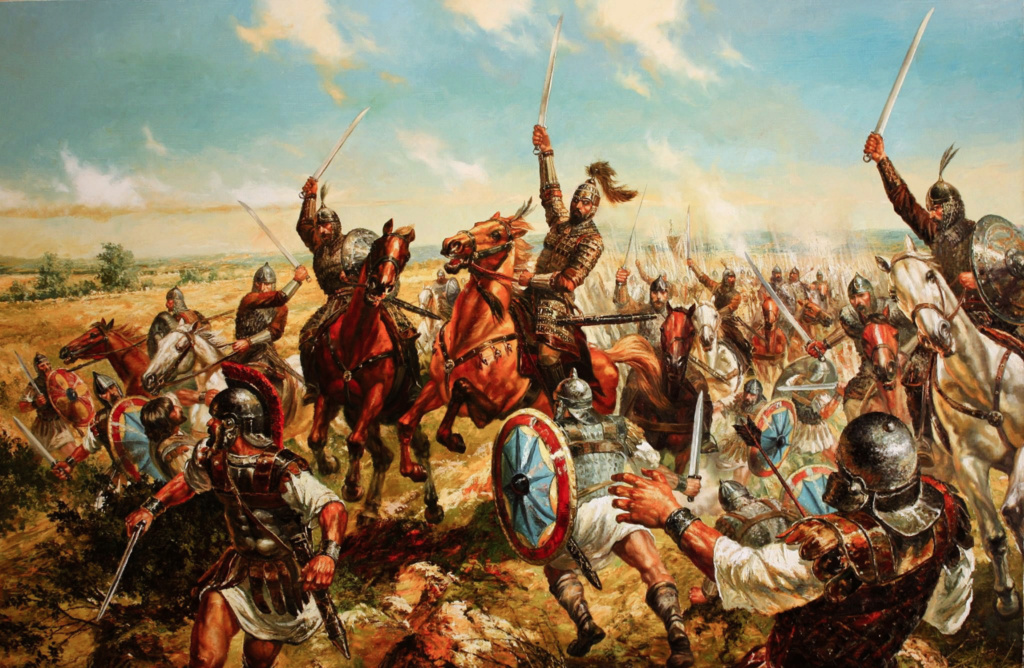The Arab “invasions” in the narratives of the conquered: This is how the conquered viewed the Saracens (Arabs) before the “invasions”!

Peoples do not suddenly appear on the stage of history... So was the case of the Arabs, who had close ties with the rest of the civilizational centers surrounding the Arabian Peninsula, whether in trade or the accompanying exchange of culture.
Peoples do not suddenly appear on the stage of history... So was the case of the Arabs, who had close ties with the rest of the civilizational centers surrounding the Arabian Peninsula, whether in trade or the accompanying exchange of culture.
However, the historical sources of the conquered peoples in the “invasions” did not agree on the origin and separation of the Arabs, nor did they agree on their characteristics or their names.
This was the case of the Greek and Roman historians, who got acquainted with the Arabs before Islam, and the case of the later sources on the “invasions” as well.
The names of these invaders, that is, the Arabs, were numerous, and the most common ones were: the Saracens, the Tayyun, the Hagarenes, and the Ismailis.
The Ismailis here do not mean the band that appeared later, but the descendants of Ishmael who was born to Abraham from Hagar, who was a servant to his wife Sarah according to the different translations of the Torah.
As for the Saracen name, it is not close to understanding, and it was mentioned for the first time in ancient Greek literature, in what appears to be a reference to a specific tribe in the Sinai desert.

And if we can conclude from the Greek writings that it is a merger of the term Sarak, and Enos, which is attached to the ratio, the meaning of the first term remained ambiguous. Some believe that it means the East, and some that it is a name for the al-Sawarka tribe, which was in the past a name for a place north of Yathrib (the city).
Others also do not rule out that it is derived from Al-Sarah Mountain in the Hijaz, while others believed that it was derived from the word desert.
However, the historian Eusebius (the father of ecclesiastical history) was the first to consider the Saracens as one of the peoples mentioned in the Torah. That is, the sons of Ishmael, rather; The nation that was “deprived of the divine promise” (the Promised Land).
This point, by the way, will be important in understanding the conquered peoples for the reasons for the “invasions”.
The use of the name Saracens expanded in the Middle Ages from Byzantine to the West in general, after its transfer from Latin and conversion from Sarakenos to Saracens, to refer to Muslim peoples.
In fact, the Europeans refrained from calling Muslims “Muslims”, preferring ethnic or tribal adjectives, in an attempt to belittle the Islamic religion. They called them the Saracens, the Moro, the Turks, or others.
… The Muslims did the same with regard to the peoples with whom they came into contact, such as their preference for the name “Franks”, for example.

Nevertheless, Hajar continued to chase the Arabs, as the Arabs of Syria used to call all Arabs the Hagarenes, while the Christians in Syria used the word Tai or Tai when talking about the Arabs, in reference to the well-known Tai tribe, some of whose clans had been converted to Christianity. It seems that the Persians were the ones who circulated the name of the Tayis to the Arabs.
Hagar, by the way, although it does not occupy an important position in the Islamic text, but for the peoples that the Arabs came as invaders, like their son Ishmael, they occupy an important position for what the Christians and Jews of the East knew about these two personalities from the texts of the Old Testament.
The Byzantine historian Suzuman indicates that the Arabs may have learned through Christianity about their relationship with Ishmael, so they followed the Jews in a number of their rituals, as they were circumcised and abstained from eating pork as well, before they deviated from commitment to Jewish rituals under the influence of time and neighboring nations.
What concerns us here is that knowledge of the Ismaili origin gave the Arabs a new identity. It made them see themselves - at least - as a biblical people.
Meanwhile, many Arabs condemned Christianity, and the adoption of this new religion may be an attempt to get rid of the reputation with which the Torah branded the Arabs by descending from Hagar. the maid.
Sozoman believes that the Arabs who did not convert to Christianity, and later formed the ground on which Islam emerged, did not find it embarrassing to derive from Ismail, but with an emphasis that their true lineage is related to Abraham, not his maidservant and her son.
Nevertheless, the original Arab countries, from which the “invasions” were launched, remained obscure in the sources of the conquered. In fact, the issue of “invaders” has historically not been of concern to the peoples who have been subjected to invasions.

The peoples who were invaded by the Arab invaders viewed them as a disaster that befell them, and did not show interest in getting to know their beliefs and ideas, least of all their ways of living and their social, political and cultural structures, except when the Arabs settled in Iraq, Spain and the Levant.
Even when Western scholars in the seventeenth century tended to rediscover the Arabs, they found that the Arabic texts, historical and religious, did not help to develop a logical sequence of the relationship of the Arabs as a people that existed in reality, with the Arabs whom the Torah spoke of.
In this context, there is a word that has always aroused the interest of scholars without finding an explanation for it. This word is “Hanif,” which could have been a key to explaining the transmission of the Abrahamic religion to the Arabs.
Another aspect referred to by ancient Arab sources and neglected by contemporary Arab historians is that related to the human composition of the Arab invasion armies.
This remark opens the door to an unfulfilled discussion about the presence of many Christians among the Arab arrivals: Who were the “invasion” armies made up of, whether on a religious or ethnic level?
Arab sources spoke at length about the tribal affiliations of these people, but information is scarce about the religious affiliations of those who participated in the first wave of invasions.
At that time, many of the largest Arab tribes professed Christianity, despite their different churches, such as Taghlib, Lakhm, Judham, Ayad, and many others. But there is an episode missing here, for example: While Iyad migrated deep into the Byzantine lands rejecting Islam, Taghlib, the most numerous, participated in the invasions!

We understand from the foregoing, then, that the Arabs were not unknown to their neighbors... Their primitive attacks were familiar. However, the expansion of the “invasions” was surprising and other peoples did not notice it immediately because of the negative image of the Saracens that was entrenched in their minds, and they did not even understand the religious content of those “invasions”.
Then one day it happened that terror replaced the contempt they showed towards the Arabs, and that was with the launch of the “invasions” between Mecca and the Euphrates!
Source: websites

